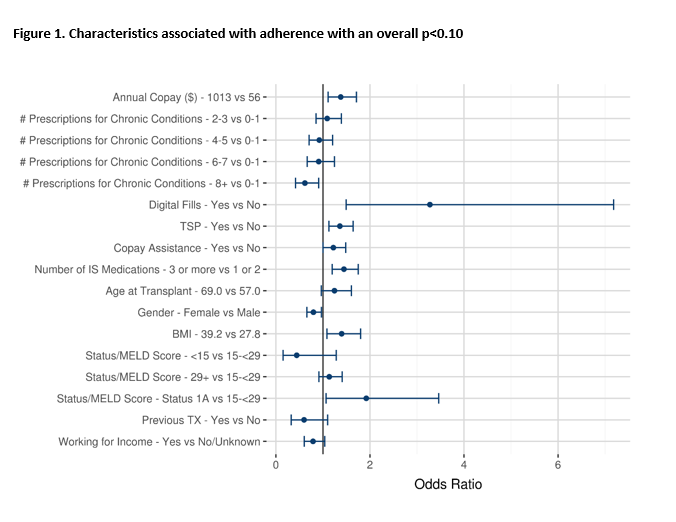Immunosuppressant Adherence in Adult Liver Transplant Recipients in the United States
W. S. Cherikh1, A. R. Wilk1, J. Maghirang1, E. A. Witt2, H. Kirkham2, S. Boghani2, N. Hira3, G. Pietradoni2, D. K. Klassen1
1United Network for Organ Sharing, Richmond, VA, 2Walgreen Co, Deerfield, IL, 3AllianceRx Walgreens Prime, Orlando, FL
Meeting: 2019 American Transplant Congress
Abstract number: D309
Keywords: Immunosuppression, Liver, Multivariate analysis
Session Information
Session Name: Poster Session D: Psychosocial and Treatment Adherence
Session Type: Poster Session
Date: Tuesday, June 4, 2019
Session Time: 6:00pm-7:00pm
 Presentation Time: 6:00pm-7:00pm
Presentation Time: 6:00pm-7:00pm
Location: Hall C & D
*Purpose: We sought to determine the characteristics associated with immunosuppressant (IS) medication adherence among adult recipients of deceased donor liver transplants (TXs) in the US.
*Methods: Prescription claims data for IS medications from a single, large national pharmacy chain during 2013-2016 were merged with the Organ Procurement and Transplant Network (OPTN) data. The study included adult recipients of deceased donor liver TXs performed within a year (± 90 days) prior to the first fill, and who had >=2 pharmacy claims for any IS at least 150 days apart in the 12-months after their first fill in the study period. The cohort was further limited to recipients with at least 2 years of graft survival. Adherence to IS medication was defined as proportion of days covered by pharmacy claims of >=90%. An explanatory logistic regression model for adherence was developed using various patient and pharmacy claims characteristics. The results are summarized as odds ratio (OR), 95% confidence interval of OR, and p-value. Statistical significance was defined as p<0.05 and marginal significance as p-value between 0.05 and 0.10.
*Results: Among 2,206 recipients in the study cohort who received liver transplants during 2011-2015, 1,004 (46%) were adherent. Figure 1 illustrates characteristics associated with adherence with an overall p<0.10. Characteristics significantly associated with increased adherence included higher amount of copay, having at least 50% of the IS filled digitally through internet or app, having at least 50% of fills at a TX specialized pharmacy (TSP), receiving copay assistance, number of IS medications of 3+, higher BMI, and Status 1A recipients. Older age at TX was marginally associated with increased adherence. Characteristics associated with significantly decreased adherence were number of prescriptions for chronic conditions of 8 or more and being female. Recipient who received a previous liver TX and those who worked for income at the time of transplant were marginally associated with decreased adherence.
*Conclusions: Using this approach for combining pharmacy claims with OPTN data, we found overall adherence in liver transplant recipients to be relatively low. Additionally, we found both financial and clinical factors were associated with IS adherence. Further studies are warranted to understand patterns of adherence among transplant recipients.
To cite this abstract in AMA style:
Cherikh WS, Wilk AR, Maghirang J, Witt EA, Kirkham H, Boghani S, Hira N, Pietradoni G, Klassen DK. Immunosuppressant Adherence in Adult Liver Transplant Recipients in the United States [abstract]. Am J Transplant. 2019; 19 (suppl 3). https://atcmeetingabstracts.com/abstract/immunosuppressant-adherence-in-adult-liver-transplant-recipients-in-the-united-states/. Accessed December 24, 2025.« Back to 2019 American Transplant Congress

